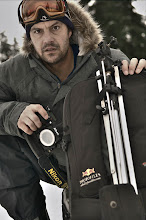In my last post I mentioned that with the new Pocket Wizards Hypersync mode they're saying that you can sync at up to 1/500th of a second and that I thought you could go faster. I'd like to clarify that a little. While Hypersync, or an early sync signal, is key to high speed sync and especially with a full frame camera, that alone won't do it. And 1/500th - 1/800th sync is pretty hard to get, 1/1000th is a little easier. The reason for that is that at 1/500th of a second shutter the opening is a slit, (see the photos in Camera Sync Speed and Flash from last July) and no matter how early you fire the flash you're not going to change that. What you need to rely on is the flash duration being slow enough to cover the entire frame as the shutter moves across it. That's kind of opposite of what we normally want for action, which is a really fast flash duration. And 1/500th shutter with 1/500 flash is often not as good at freezing as 1/250th shutter with 1/2000th flash duration.
As you've probably already guessed from reading this far there is a lot going on when you are syncing at high shutter speeds. I like to shoot at 1/1000 of a second and run my SB800's at full power. That gives me a flash duration of close to 1/1000 of a second, which is pretty close to the shutter speed, but it still doesn't quite always fill the entire frame. You will also notice that the light falls off a bit through the end of the frame as the flash duration measurement of T.5 (measured from when the flash hits full power until it drops to half power, thus the .5) includes a full one stop range in flash output. Ie at full power if the flash is at f8, when it drops to half power it'll be at f5.6, which is more than enough light to still be visible, and enough of a difference to be noticeable. Also when your flash duration is so close to the shutter speed you start to notice things like the 1/15,000 to 1/20,000 of a second irregularities in the shutter. Sometimes you see a little of the shutter curtain, sometimes you don't, there aren't many cameras that have shutters that are accurate to 1/15,000 of a second or faster.
So what I'm really saying is that to sync your flash at faster than 1/500th of a second you really need a slow duration flash, and slower is better to some extent. If you're shooting at 1/1000th and your flash duration is 1/500th, then the flash turns on, your shutter moves across the image, and then your flash turns off, with a bit of leeway on either side.
To do this you need to be able to fire the flash 1/10,000 of a second or so before the shutter opens, and you need to be able to adjust that sync point by 1/10,000's of a second to make up for variations in shutters and flashes.
David Hobby said in his review of the new Pocket Wizards on his Strobist blog that "It's only a matter of time before the message boards start lighting up with best settings for every camera and flash model combos to rack the full sync out as far as possible." Well I can tell you from experience that there is a different setting for every shutter speed and flash power combination with every different camera and flash model. So it's going to be a huge list. I started making one with exact sync offsets for my SB800's and my D2Xs and my D700 or D3 and realized that while you can get pretty close with a chart, I find I still need to finetune by 1/10,000's up and down every time I set up.
This is a lot of tech information and may be a little much for those of you that aren't total geeks, so I'll follow this up with a few more posts on the topic and eventually (hopefully soon) a video post about how to set up Pocket Wizard Multimax's to do all this.
Friday, February 20, 2009
Subscribe to:
Post Comments (Atom)


No comments:
Post a Comment